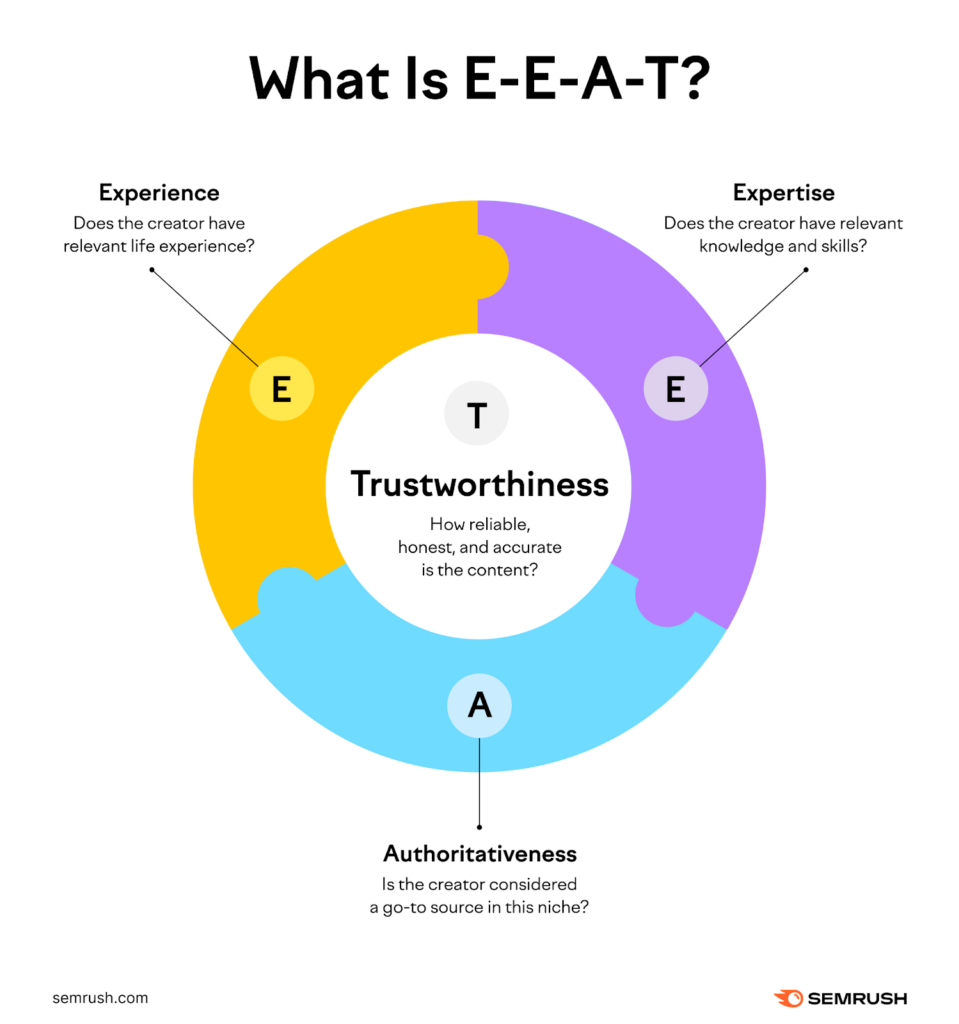Businesses must leverage effective strategies to connect with their audience and drive measurable outcomes. Content marketing has emerged as a cornerstone of modern marketing, playing a important role in establishing brand credibility, attracting potential customers, and generating valuable leads. However, successful implementation requires a deep understanding of various content types, clear objectives, and adherence to industry standards, such as Google’s EEAT guidelines, which prioritize experience, expertise, authority, and trustworthiness.
This guide aims to provide a comprehensive breakdown of content marketing, covering its significance, diverse types, and strategies. It will also delve into how aligning your content creation efforts with Google’s standards can significantly enhance the quality and impact of your marketing campaigns. By the end, you’ll gain actionable insights on crafting a good content marketing strategy that not only enhances visibility but also drives meaningful engagement with your target audience.

What is Content Marketing?
At its core, content marketing is a strategic approach that focuses on creating and distributing valuable content to attract and engage a specific target audience. The goal is to establish trust, increase brand awareness, and drive profitable customer actions, such as lead generation and conversions. Content can come in many forms, such as blog posts, videos, social media updates, and email newsletters, all aimed at addressing the needs and pain points of your audience.
Why Content Marketing Is Important
Enhances Brand Recognition
Content marketing helps businesses get in front of their audience at various touchpoints. Whether it’s through social media posts, articles, or videos, your brand becomes visible to more people. When your content resonates with your audience, it encourages them to share it, which amplifies your brand’s reach organically.
Builds Trust and Authority
One of the key benefits of content is the ability to establish your business as an authority in your industry. When you provide helpful, informative, and accurate content consistently, your audience starts seeing you as a reliable source of knowledge. This trust strengthens relationships and can lead to repeat business and long-term customer loyalty.
Facilitates Lead Nurturing
Content allows you to engage prospects through various stages of the buyer’s journey. Whether they are just becoming aware of your brand or they’re ready to make a purchase, you can use content to educate, inform, and influence them in a way that builds trust, keeping your business top-of-mind when it’s time to convert.
Improves SEO and Website Traffic
By creating content that answers specific questions or addresses pain points, you increase the likelihood of ranking higher on search engines. This organic traffic is valuable because it’s made up of people who are actively seeking information that your content provides.
Types of Content
There’s no one-size-fits-all approach to content marketing. Different types of content work better for different objectives, audience types, and stages in the buyer’s journey. Let’s take a closer look at the different forms of content you can leverage:

Blog Posts
Blogs are a staple in content marketing. Well-written blog help businesses build their online presence by offering valuable, in-depth information to their target audience. They also enhance SEO efforts by targeting long-tail keywords and improving organic search rankings.

Social Media Posts
With billions of people using social media platforms, this type of content offers an opportunity to engage with your audience in real time. Posts can include everything from text updates and infographics to video snippets and carousels. Social media helps increase brand awareness and build relationships with customers.
Videos
Video is one of the most engaging types of content on the internet. Videos can be used to show how products work, share customer testimonials, or even provide entertainment. Videos help businesses increase engagement, improve user experience, and provide a more personal connection to their audience.
Podcasts
Podcasts are rapidly growing in popularity, especially in industries where thought leadership and education are valued. They allow brands to provide in-depth discussions, share expertise, and engage an audience that prefers listening over reading.
Infographics
Infographics are highly shareable and easy to understand. They break down complex data or concepts into digestible, visual formats that are both informative and engaging.
Email Campaigns
Email content provides a direct line to your audience. From welcome emails and newsletters to drip campaigns and promotional content, email is an essential tool for nurturing leads and converting prospects into customers.
Case Studies & Testimonials
Real-world examples of how your product or service helped a customer can be powerful. These provide social proof, which can sway potential customers who are on the fence about making a purchase.

Developing a Content Marketing Strategy
Having a content marketing strategy ensures that your efforts align with your business goals and objectives. Here are key elements to include when creating a strategy:
Identify Your Audience
Understanding your target audience is critical. What are their needs, challenges, and interests? Segmenting your audience based on demographics and behaviors will help you craft content that speaks directly to them.
Set Clear Goals
Whether you want to increase brand awareness, generate more leads, or improve customer retention, it’s essential to set specific and measurable goals for your content marketing efforts.
Create Engaging Content
The content you create should always aim to educate, entertain, or inform your audience. It should offer value and solve problems that your audience faces. High-quality content that resonates with your target audience will drive greater engagement.
Promote and Distribute Content
Content marketing doesn’t end once the content is published. To ensure your content reaches your audience, you need to promote it across various channels. This could include social media platforms, email lists, and partnerships with influencers or other businesses.
Measure and Adjust Your Strategy
To know if your strategy is working, it’s important to track key performance indicators (KPIs). These might include website traffic, lead generation, engagement rates, and conversions. Use this data to optimize and adjust your strategy for better results.

Integrating EEAT into Your Content
Focus on High-Quality, In-Depth Content
EEAT emphasizes content that answers users’ questions thoroughly. It’s important to create content that is not only comprehensive but also well-researched and up-to-date. Providing value to your audience through well-structured, informative content will improve your site’s authority and trustworthiness.
Leverage Testimonials and Social Proof
Including testimonials, reviews, and client success stories can also build trust and authority. These forms of social proof validate the quality and effectiveness of your services, encouraging more visitors to engage with your business.
Cite Your Sources and Be Transparent
For content to be trusted, you must demonstrate its factual accuracy. Cite your sources clearly, use data-driven insights, and ensure you link to authoritative references. Being transparent about how you gather your information not only boosts trustworthiness but also complies with Google’s E-E-A-T guidelines.
Maintain a Consistent Content Calendar
Publishing content regularly helps maintain your site’s credibility and visibility. A well-maintained blog or resource section with fresh updates shows that your brand is an active participant in the industry, building both authority and trust with your audience.
By creating content that aligns with Google’s EEAT guidelines, you can significantly improve your visibility in search engine results, foster trust with your audience, and build a long-term, positive reputation online.
Final Thoughts
Incorporating Google’s EEAT guidelines into your content strategy is a powerful way to increase your content’s quality and visibility on search engines. By ensuring that your content demonstrates experience, expertise, authority, and trustworthiness, you will not only meet Google’s standards but also build a loyal, engaged audience. Remember, creating valuable content consistently is key to establishing your brand as a trusted resource in your industry.
The Power of Storytelling in Content
Incorporating storytelling into your content marketing efforts is a highly effective way to connect with your audience. People don’t just want facts; they want a narrative they can relate to. When you tell stories about how your product or service has made a positive impact, it humanizes your brand and makes it more relatable.
Storytelling can be used across all forms of content, from blog posts and videos to social media posts and email newsletters. The key is to ensure that your stories resonate with your audience’s emotions and provide them with solutions to their problems.
The Role of Data in Content Marketing
Data is the backbone of effective content marketing. By using analytics tools, you can better understand what types of content are resonating with your audience, what drives conversions, and which topics are the most engaging. This data-driven approach helps refine your content and ensures you’re meeting the needs of your target audience.
FAQs About Content Marketing
How long does it take to see results from content marketing?
Results vary depending on factors like your industry, goals, and content quality. Typically, businesses start to see measurable results after about 6 to 12 months of consistent effort.
What is the difference between content marketing and traditional advertising?
Traditional advertising focuses on promoting a product or service directly through paid channels. Content marketing, however, focuses on providing valuable content that attracts and engages an audience without the hard sell.
How do I know what content my audience wants?
The key is to listen to your audience through social media interactions, comments, and feedback. Additionally, using analytics tools and conducting surveys can help you identify the types of content that resonate with your audience.
Conclusion
Content marketing is one of the most powerful tools available for businesses seeking to grow their brand, connect with their audience, and drive conversions. By understanding its various forms and how to leverage them effectively, you can create a content marketing strategy that delivers measurable results.
Whether you’re just getting started or looking to improve your current efforts, consistent, valuable content is the key to long-term success.
Ready to take your content marketing to the next level? Contact Skybound Digital, your trusted web design and marketing partner in Oklahoma. Let us help you craft a strategy that attracts, engages, and converts your audience effectively.
